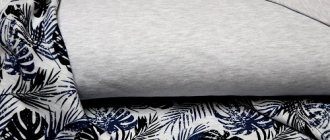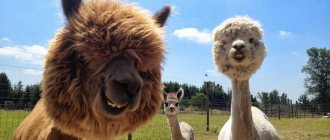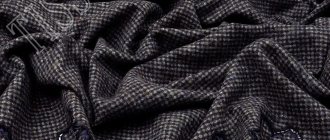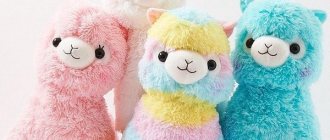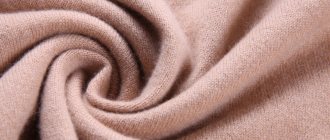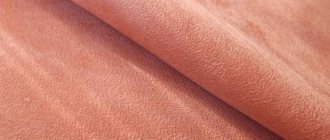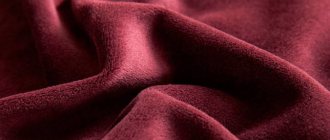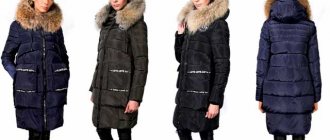Wardrobe elements made from natural materials have been the warmest, most durable and practical for centuries. Products made from alpaca wool are especially popular. Sweaters, coats, skirts or suits made from warm yarn are lightweight and look great.
Despite the thinness of the products, they retain heat well, allow air to pass through, and do not interfere with the “breathing” of the body. But in order for the elements to please with their aesthetics and pleasant texture during long wear, you need to know how to care for alpaca wool. Proper care, washing and storage are the key to the durability of warm products that can last for more than one season.
Properties
Alpaca is a warm and luxurious fabric that combines the healing properties of camel wool and the softness of llama wool. These fibers are ideal for various weaves because they have no shape memory. It should be noted that alpaca is never dyed. It has 22 natural shades, which in the color palette range from pure white to black.
Compared to sheep wool, alpaca fibers are 3 times stronger and 7 times warmer. In addition, it stands out for its increased lightness and durability. The structure of alpaca wool is smooth, so products made from it are very soft and do not cause discomfort when in contact with the human body.
Fabrics made from alpaca do not stretch or wrinkle, and are resistant to stains. Products made from this type of wool are not subject to pilling or felting. In addition, this fabric does not cause allergic reactions and has antiseptic properties.
Alpaca wool is also known for its protection from both cold and heat. Things made from this type of fabric are comfortable in all weather conditions: they are not hot in summer and not cold in winter. Its only drawback is its high price.
A little about yarn
Let's figure out what alpaca yarn is. This is a unique type of fabric that is used to create outerwear or wardrobe items for the winter, cold season. The thin fabric's texture resembles suede, sheared fur or velvet. The wool of a South American animal is used to make the material. Its “fur coat” is a soft, long fleece that can be curly or even. Alpaca wool is luxurious and silky and comes in a huge variety of shades. There are over 20 colors in nature, and modern technologies make it possible to create materials in brighter, artificial shades.
Twice a year, the llama’s “fur coat” is sheared and becomes the basis for first-class fabrics for sewing wardrobe items. Natural fiber creates the effect of dry heat, and items made from wool are pleasant to the body and provide excellent warmth in any weather conditions. Alpaca yarn can be used to create various textiles and accessories. The fabric is especially in demand for coats, jumpers, mittens, scarves, and mittens.
Application area
Alpaca wool clothing was once considered worthy of being worn only by Inca kings. Now everyone can afford products made from this fabric. In addition, today alpaca wool is often used for crocheting, knitting, spinning, and fabric production.
Alpaca wool can be used to produce:
- Scarves and caps, hats;
- Socks;
- Sweaters;
- Coats and jackets, jackets;
- Carpets, rugs.
Fabric made from the wool of young animals is used to make clothing, and fibers that are sheared from older animals are used to make carpets.
There are several types of wool, which differ in fiber diameter:
- Royal alpaca - 19 microns.
- Baby alpaca has a diameter of 22.5 microns.
- Very soft alpaca with a fiber diameter of 25.5 microns.
- Adult alpaca fibers are 32 microns
Baby wool is considered the highest quality fabric. There are two types of animals: Alpaca Huacaya is the most common species, which looks like a small fluffy bear, and Alpaca Suri. The second type is rarer and therefore valuable. His hair is considered the best material in the whole world.
Alpaca animal
Alpaca - what is it and where does it live? Habitat of the alpaca, a domestic artiodactyl animal, South America. For most of the representatives of this species, the habitat is Peru. Alpaca is kind by nature, very inquisitive and smart, and its wool is used to make the most expensive in its category, but useful fabric.
Alpaca product
Origin story
Alpaca is a representative of camelids. This animal was first domesticated by the Incas more than 6,000 years ago. Historically, alpacas like to stay in herds, so it is impossible to keep the animal alone. To tame an artiodactyl, you need to have patience and perseverance. If an animal makes friends with a person, then it can easily withstand any climate change.
What does an alpaca eat? The most important ingredients are salt and water, as well as oatmeal, rye bread and grass in any form.
How much does an alpaca weigh? Adults weigh about 70 kg, and the total volume of wool that can be collected from an animal per year is 10 kg.
Alpaca Huacaya domestic
The history of the origin of alpaca fabric
Several thousand years ago, alpacas were domesticated by the inhabitants of the South American Andes. During the Inca Empire, their wool was the local currency and was valued for its unique color as well as the highest quality.
Unfortunately, when the Spaniards came to South America, they did not appreciate the properties of the wool of these animals and began to breed sheep. Alpacas only returned to popularity in 1984, when animals from Chile began to be imported to the United States.
Today, the largest supplier of alpaca wool is Peru. They produce about 4,000 tons per year, while the fibers from the animals are cut once every two years.
Value
Various variations of alpaca products are priced differently. Suri yarn is a high-quality raw material from which the most expensive things are made.
The use of merino or silk thread, as well as other natural materials, reduces the cost of products. Mixing alpaca wool with synthetic raw materials makes the product accessible to the average person.
In some countries (USA) there are factories for hand-made clothing and interior items from artiodactyl wool. In this way, they are trying to reduce the cost of goods and make it possible for everyone in the country to purchase a quality product.
Production
Alpacas are bred only for the purpose of producing animal hair. But, even though shearing does not occur so often, an adult individual produces up to three kilograms of high-quality wool at a time. Melanged fibers are sorted exclusively by hand, which ensures unrivaled quality of the finished material.
Once the wool fibers are sorted, dirt, sand, grass and thorns are removed. The next step is the process of spinning wool. The fabric must then be washed to remove any remaining dirt and grease. If there is a need, then after all stages you can start painting the fibers. After processing, wool can be stored for a considerable time without losing its qualities.
Advantages and disadvantages
The positive aspects of alpaca wool depend on the type of animal used. General positive qualities arise from the properties of this material:
- moisture resistant;
- soft and light;
- acts as a heat regulator;
- hypoallergenic;
- The fabric is suitable for children and animals, as it is not itchy. Fur is used to make interior items.
There are also a number of negative aspects:
- High cost of goods. Many people note that for the price of an alpaca wool product you can buy the best product.
- Reduced quality when mixing wool with synthetics. When trying to make alpaca clothing affordable, some important properties of the product are lost (softness and lightness, water resistance).
- Difficult to care for. Alpaca is a demanding fabric that requires careful care, so it is not surprising that many people refuse to buy a natural product due to difficulties with cleaning.
You might be interested in: Features and properties of organic cotton
Alpaca, like any other fabric, has its pros and cons, but due to its uniqueness, it has become widespread not only among fashion designers, but also among ordinary people.
Caring for alpaca wool products
The first thing you need to know about caring for alpaca clothing is how to store it. This type of wool does not tolerate the presence of naphthalene, therefore, to protect products from moths, it is better to use cedar, lavender or tobacco.
Yarn or clothing made from alpaca fibers should be washed in cold water with the addition of special detergents. It is better not to wring things out, but to dry them naturally, away from heaters and direct sunlight. Lay the garment out on a flat surface while shaping it by lining up the sleeves and side seams by hand. This will prevent the item from becoming deformed when drying.
Alpaca wool clothing should be ironed gently through a damp cloth. In order to preserve the item, you need to wash it every six to seven wears. To restore the lint a little, simply run a soft sponge or brush over the clothing. Alpaca items can be dry cleaned.
For many years now, this material has been proving its excellent quality in support of its high pricing policy. Many sports companies have paid attention to clothing made from this type of wool due to its ability to thermoregulate and use it to sew uniforms. It is the unique properties and wear resistance that make wool products so popular at any time of the year.
Even for animals they sew warm clothes from alpaca wool.
Determining the quality level of the material
alpaca fabric such a coat
alpaca scarf
alpaca sweater
alpaca coat
Real alpaca wool is a high-quality and expensive material. In order to be confident in your purchase, you must follow a few simple rules.
- You need to buy yarn from well-known world manufacturers in large stores. For example, high-quality 100% yarn for hand knitting is supplied to Russia:
- MALABRIGO, country of origin Uruguay;
- Swiss company LANG YARNS;
- LAMANA, Germany;
- price for 50 gr. yarn starts from 1200 rubles;
- Manufacturers add sheep wool, acrylic, polyamide to cheaper yarn - the percentage is indicated on the packaging.
- A 100% alpaca coat is an expensive proposition. If the seller offers to buy something costing less than 45,000 rubles, then the quality of the material must be questioned. The advantage of natural clothing is excellent thermal insulation. When trying on a coat even in the heat, thanks to the unique properties of the fabric, a person does not sweat. If after putting on a coat the buyer feels hot and stuffy for 5-10 minutes, then chemical fibers are clearly added to the fabric.
- Alpaca carpets are exclusive items that cost dozens of dollars. They are sold only by specialized boutiques.
Important - products made from 100% alpaca have soft natural tones. The manufacturer never paints the canvas in bright, trendy colors.
Review
Products made from alpaca material have become widespread throughout the world, so many ladies are interested in what this wool has to offer.
Feedback from the girl Alesya, who rated the alpaca wool coat five points: “I wear the coat carefully, because I hope for its long service. The alpaca didn’t know what kind of material this was. I got it in mustard color with a metal button. The fitted model looks simply chic. I rate it 5 points and recommend it to everyone. The only negative is its cost."
Coat
Small products made from alpaca wool are also in demand. Thus, a girl with the nickname “Barbie Doll” purchased socks back in 2013 at a pharmacy for 200 rubles. and shared her feelings: “Until that moment, I didn’t know what alpaca was, but I bought socks and, as it turned out, they are very warm. I wear them to the skating rink. The product itself is very dense, but soft and light. Despite the fact that socks perfectly protect your toes from frostbite, your feet don’t sweat in them at all. Among the additional properties, they have an antimicrobial effect, which helps to avoid fungus.”
Socks
Thus, products made from this wool allow you not to freeze in severe frost and avoid various diseases. Alpaca wool fabric is a sought-after product. Due to their softness and lightness, many people love blankets and cardigans made from the fur of these animals. Only the high cost deters some from purchasing, as well as painstaking care.
